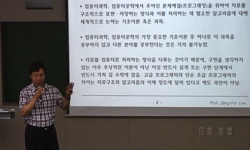다차원 문항반응이론(MIRT) 척도연계 방법은, 공통 문항 혹은 공통 피험자에 기초하여, 두 다차원 능력척도를 연계하는 함수의 회전행렬과 위치벡터를 추정한다. MIRT 연구에서 척도연계의 필...
http://chineseinput.net/에서 pinyin(병음)방식으로 중국어를 변환할 수 있습니다.
변환된 중국어를 복사하여 사용하시면 됩니다.
- 中文 을 입력하시려면 zhongwen을 입력하시고 space를누르시면됩니다.
- 北京 을 입력하시려면 beijing을 입력하시고 space를 누르시면 됩니다.

모수 복원 상황에서 MIRT 척도연계 방법의 기능 진단 = Investigation of Three MIRT Scale Linking Methods Under the Context of Parameter Recovery on the True Simulation Scale
한글로보기https://www.riss.kr/link?id=A102576374
- 저자
- 발행기관
- 학술지명
- 권호사항
-
발행연도
2016
-
작성언어
-
- 주제어
-
KDC
370
-
등재정보
KCI등재
-
자료형태
학술저널
- 발행기관 URL
-
수록면
669-696(28쪽)
-
KCI 피인용횟수
4
- 제공처
-
0
상세조회 -
0
다운로드
부가정보
국문 초록 (Abstract)
다차원 문항반응이론(MIRT) 척도연계 방법은, 공통 문항 혹은 공통 피험자에 기초하여, 두 다차원 능력척도를 연계하는 함수의 회전행렬과 위치벡터를 추정한다. MIRT 연구에서 척도연계의 필요성은 임의의 “0-I” 능력척도 상에서 추정된 문항모수와 기저 능력분포를 목표하는 모집단 능력척도 상에서 복원하고자 할 때 전형적으로 발생한다. 본 연구는 공통-문항 기반 MIRT 척도연계를 위해 제안된 세 가지 방법, Direct 방법, TCF 방법 및 LLM방법의 특성과 기능을 모수 복원 상황을 전제로 하여 비교 분석하고자 하였다. 세 척도연계 방법의 특성과 기능이 뚜렷이 드러나도록 모집단 능력분포의 평균, 분산 및 공분산을 특정한 값으로 설정하여 모의실험을 실시하였다. 주요 결과는 다음과 같았다. 첫째, Direct, TCF 및 LLM 방법은 모두 비대칭적으로 척도연계를 수행하였다. 둘째, Direct 및 TCF 방법은 사각(oblique) 회전행렬을 추정함으로써 목표 능력척도 상에서 문항모수 및 모집단 능력분포를 적절히 추정한 반면, LLM 방법은 준-직교(pseudo-orthogonal) 회전행렬을 추정함으로써 모집단 능력 변수들 간의 상관이 0에 가까운 경우를 제외하고 문항모수와 능력분포를 편향 추정하였다. 셋째, 세 척도연계 방법 모두는 연계하고자 하는 두 능력척도 간 능력차원의 연결 문제를 완전히 수리적으로 해결하며 따라서 한 능력척도 상에서의 능력차원의 순서가 다른 능력척도 상에서 바뀔 수 있었다. 이러한 주요 결과와 관련하여, 세 척도연계 방법의 실제 사용상의 유의점과 개선 방향에 대해 논의하였다.
다국어 초록 (Multilingual Abstract)
In multidimensional item response theory (MIRT), scale linking methods, developed under the anchor-item or common-examinee design, attempt to estimate the rotation matrix and location vector of the linking function that connects two multidimensional a...
In multidimensional item response theory (MIRT), scale linking methods, developed under the anchor-item or common-examinee design, attempt to estimate the rotation matrix and location vector of the linking function that connects two multidimensional ability scales (i.e., coordinate systems). In MIRT applications, the need for scale linking typically occurs when the recovery of parameters is being investigated and the parameters that are expressed on an arbitrary “0-I” scale should be placed onto the true simulation scale. Assuming such a parameter-recovery situation, the present study investigated the characteristics and performances of the three “common-item” based MIRT linking methods, Direct, TCF, and LLM. A critical study factor was the population two-dimensional ability distribution, whose means, variances and covariance were varied so that the characteristics and performances of the three methods might be clearly revealed. The major results were as follows. First, all three methods performed “non-symmetric” scale linking. Second, in the recovery of item parameters and ability distributions on the simulation scale, the Direct and TCF methods performed well because they estimated “oblique” rotation matrices. On the other hand, the LLM method recovered poorly the parameters except when the population covariance was zero, because it estimated “pseudo-orthogonal” rotation matrices. Third, it was observed for all the linking methods that the dimension-matching between two multidimensional scales was determined entirely by mathematics and thus the order of dimensions in the ability scale prior to scale linking could be changed after scale linking.
목차 (Table of Contents)
- 국문초록
- Ⅰ. 서론
- Ⅱ. MIRT 척도연계 방법
- Ⅲ. 연구방법
- Ⅳ. 연구결과
- 국문초록
- Ⅰ. 서론
- Ⅱ. MIRT 척도연계 방법
- Ⅲ. 연구방법
- Ⅳ. 연구결과
- Ⅴ. 논의 및 결론
- 참고문헌
- ABSTRACT
참고문헌 (Reference)
1 민경석, "다차원 문항반응모형의 척도연계방법" 한국교육평가학회 19 (19): 1-20, 2006
2 Loyd, B. H., "Vertical equating using the Rasch model" 17 (17): 179-193, 1980
3 Ackerman, T. A., "Using multidimensional item response theory to understand what items and tests are measuring" 18 (18): 255-278, 1994
4 Reckase, M. D., "The vertical scaling of science achievement tests" Michigan State University 2004
5 Min, K. -S., "The impact of scale dilation on the quality of the linking of multidimensional item response theory calibrations" Michigan State University 2003
6 Reckase, M. D., "The difficulty of test items that measure more than one ability" 9 (9): 401-412, 1985
7 Kolen, M. J., "Test equating, scaling, and linking: Methods and practices" Springer 2014
8 Wilson, D. T., "TESTFACT: Test scoring, item statistics, and item factor analysis [Computer software]"
9 R Development Core Team, "R: A language and environment for statistical computing"
10 Muraki, E., "PARSCALE: IRT item analysis and test scoring for rating-scale data [Computer software]"
1 민경석, "다차원 문항반응모형의 척도연계방법" 한국교육평가학회 19 (19): 1-20, 2006
2 Loyd, B. H., "Vertical equating using the Rasch model" 17 (17): 179-193, 1980
3 Ackerman, T. A., "Using multidimensional item response theory to understand what items and tests are measuring" 18 (18): 255-278, 1994
4 Reckase, M. D., "The vertical scaling of science achievement tests" Michigan State University 2004
5 Min, K. -S., "The impact of scale dilation on the quality of the linking of multidimensional item response theory calibrations" Michigan State University 2003
6 Reckase, M. D., "The difficulty of test items that measure more than one ability" 9 (9): 401-412, 1985
7 Kolen, M. J., "Test equating, scaling, and linking: Methods and practices" Springer 2014
8 Wilson, D. T., "TESTFACT: Test scoring, item statistics, and item factor analysis [Computer software]"
9 R Development Core Team, "R: A language and environment for statistical computing"
10 Muraki, E., "PARSCALE: IRT item analysis and test scoring for rating-scale data [Computer software]"
11 Dennis, J. E., "Numerical methods for unconstrained optimization and nonlinear equations" Society for Industrial and Applied Mathematics 1996
12 Fraser, C., "NOHARM: A computer program for fitting both unidimensional and multidimensional normal ogive models of latent trait theory [Computer software]"
13 Oshima, T. C., "Multidimensional linking : Four practical approaches" 37 (37): 357-373, 2000
14 Reckase, M. D., "Multidimensional item response theory" Springer 2009
15 Bock, R. D., "Marginal maximum likelihood estimation of item parameters : Application of an EM algorithm" 46 : 443-459, 1981
16 Davey, T. C., "Linking multidimensional item calibrations" 20 (20): 405-416, 1996
17 Ogasawara, H., "Least squares estimation of item response theory linking coefficients" 25 (25): 373-383, 2001
18 Marco, G. L., "Item characteristic curve solutions to three intractable testing problems" 14 (14): 139-160, 1977
19 Lee, K., "IPLINK: Multidimensional and unidimensional item parameter linking in item response theory" 20 (20): 230-, 1996
20 Kim, S., "Handbook of polytomous item response theory models" Routledge 257-291, 2010
21 Bock, R. D., "Full-information item factor analysis" 12 (12): 261-280, 1988
22 Schönemann, P. H., "Fitting one matrix to another under choice of a central dilation and a rigid motion" 35 (35): 245-255, 1970
23 Min, K. -S., "Evaluation of linking methods for multidimensional IRT calibrations" 8 (8): 41-45, 2007
24 Haebara, T., "Equating logistic ability scales by a weighted least squares method" 22 (22): 144-149, 1980
25 Kim, S., "Effects on scale linking of different definitions of criterion functions for the IRT characteristic curve methods" 32 (32): 371-397, 2007
26 Stocking, M. L., "Developing a common metric in item response theory" 7 (7): 201-210, 1983
27 김성훈, "BILOG-MG를 사용한 IRT 모형 모수의 추정에서 기저 능력분포의 경험적 추정이 문항모수 추정에 미치는 영향" 한국교육평가학회 25 (25): 317-336, 2012
28 Mislevy, R. J., "BILOG 3: Item analysis and test scoring with binary logistic models" Scientific Software 1990
29 Lord, F. M., "Applications of item response theory to practical testing problems" Erlbaum 1980
30 Li, Y. H., "An evaluation of the accuracy of multidimensional IRT linking" 24 (24): 115-138, 2000
31 Divgi, D. R., "A minimum chi-square method for developing a common metric in item response theory" 9 (9): 413-415, 1985
32 Schönemann, P. H., "A generalized solution of the orthogonal Procrustes problem" 31 (31): 1-10, 1966
33 Kim, S., "A comparative study of IRT fixed parameter calibration methods" 43 (43): 355-381, 2006
동일학술지(권/호) 다른 논문
-
- 한국교육평가학회
- 정혜원(Hye won Chung)
- 2016
- KCI등재
-
공통문항 비동등집단 설계에서 다차원 문항반응모형의 연계화와 동등화 결과 비교
- 한국교육평가학회
- 정지영(Ji young Jung)
- 2016
- KCI등재
-
Fixed Parameter Calibration for Linking Multidimensional IRT Scales
- 한국교육평가학회
- 박찬호(Chan ho Park)
- 2016
- KCI등재
-
Effects of Model-Data Misfit on IRT Equating for Polytomous Data
- 한국교육평가학회
- 전경희(Kyong Hee Chon)
- 2016
- KCI등재
분석정보
인용정보 인용지수 설명보기
학술지 이력
| 연월일 | 이력구분 | 이력상세 | 등재구분 |
|---|---|---|---|
| 2026 | 평가예정 | 재인증평가 신청대상 (재인증) | |
| 2020-01-01 | 평가 | 등재학술지 유지 (재인증) |  |
| 2017-01-01 | 평가 | 등재학술지 유지 (계속평가) |  |
| 2013-01-01 | 평가 | 등재학술지 유지 (등재유지) |  |
| 2010-01-01 | 평가 | 등재학술지 유지 (등재유지) |  |
| 2008-01-01 | 평가 | 등재학술지 유지 (등재유지) |  |
| 2006-01-01 | 평가 | 등재학술지 유지 (등재유지) |  |
| 2004-01-01 | 평가 | 등재학술지 유지 (등재유지) |  |
| 2001-01-01 | 평가 | 등재학술지 선정 (등재후보2차) |  |
| 1998-07-01 | 평가 | 등재후보학술지 선정 (신규평가) |  |
학술지 인용정보
| 기준연도 | WOS-KCI 통합IF(2년) | KCIF(2년) | KCIF(3년) |
|---|---|---|---|
| 2016 | 0.91 | 0.91 | 0.99 |
| KCIF(4년) | KCIF(5년) | 중심성지수(3년) | 즉시성지수 |
| 1.02 | 1.03 | 1.646 | 0.37 |





 스콜라
스콜라






